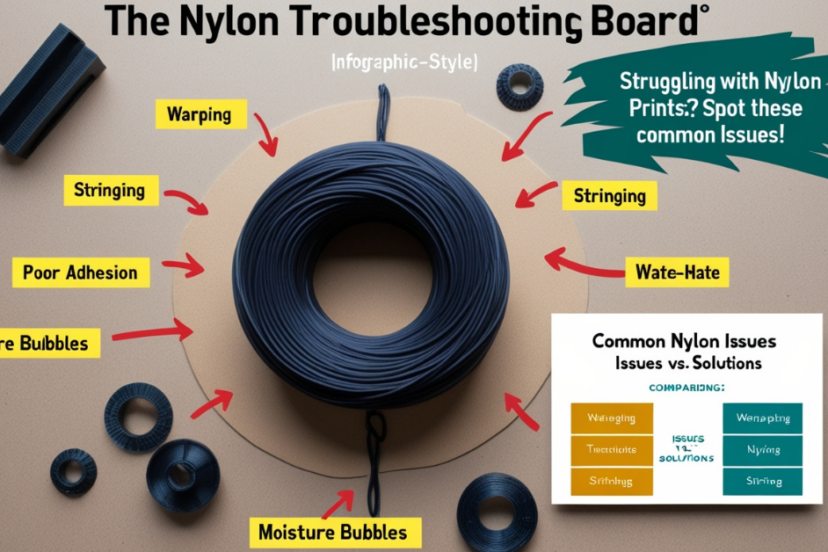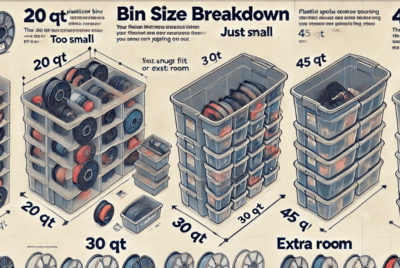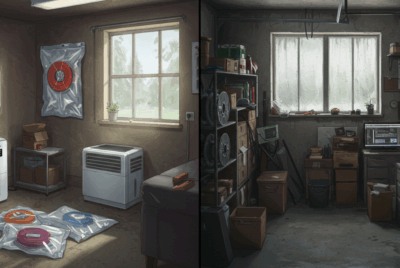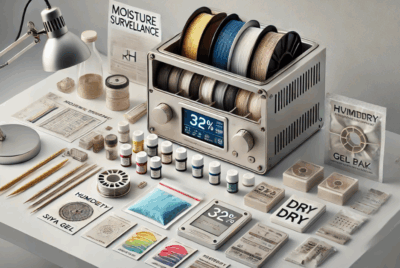What are common issues with Nylon?
While Nylon is a popular and highly versatile 3D printing material, it comes with a few challenges that users need to be aware of. Here are some common issues with Nylon filament:
1. Moisture Absorption
- Issue: Nylon is highly hygroscopic, meaning it absorbs moisture from the air very quickly. This can lead to a variety of printing problems, such as bubbling, poor layer adhesion, and surface imperfections.
- Why It’s a Problem: When Nylon absorbs moisture, it turns into steam when heated, which can cause bubbling or popping during extrusion. This moisture can also weaken the printed part, leading to brittleness and reduced strength.
- Solution: Store Nylon filament in airtight containers with desiccants, or vacuum-sealed bags to keep moisture out. You should also dry the filament before printing, using a filament dryer, oven, or food dehydrator.
2. Warping
- Issue: Nylon has a high tendency to warp, especially in larger prints or those with sharp corners. It can lift from the print bed during cooling, which leads to distortion.
- Why It’s a Problem: Warping affects print quality and can cause misalignment, layer separation, and print failures.
- Solution: Use a heated print bed, preferably at around 70°C to 90°C. Additionally, a build surface like PEI or a glue stick can help improve adhesion to the bed. Enclosed print areas also help maintain a stable temperature and reduce warping.
3. Poor Bed Adhesion
- Issue: Nylon can have trouble sticking to the print bed, especially when printing the first few layers.
- Why It’s a Problem: Without proper adhesion, the print may shift or fail, leading to poor results.
- Solution: Use a heated print bed, apply a suitable adhesion aid (such as a glue stick, hairspray, or PEI sheet), and ensure the bed is properly calibrated to improve first-layer adhesion.
4. Stringing and Oozing
- Issue: Nylon tends to string and ooze during printing, especially when printing with multiple retractions or at higher temperatures.
- Why It’s a Problem: Stringing leads to unwanted filament strings between parts, creating messy prints and requiring additional post-processing to clean up.
- Solution: Adjust your retraction settings (increase retraction distance or speed), lower the printing temperature, or fine-tune the print speed. It may also help to use a filament with a lower moisture content.
5. Difficulty in Printing
- Issue: Nylon has a higher printing temperature range compared to materials like PLA. This can make it more challenging to print with, especially on consumer-grade 3D printers.
- Why It’s a Problem: Many printers are not equipped with hotends or heated beds that can reach the high temperatures required for Nylon, leading to under-extrusion or inconsistent extrusion.
- Solution: Ensure your printer is capable of reaching temperatures of around 240°C to 260°C for the hotend and a heated bed of 70°C to 90°C. Consider upgrading your printer if necessary.
6. Brittleness After Drying
- Issue: After drying Nylon filament, it can sometimes become brittle if it’s over-dried or exposed to high temperatures for too long.
- Why It’s a Problem: Brittle filament can lead to poor print quality, breakage during printing, and more frequent clogging.
- Solution: Dry the filament in moderation. Drying times should typically be 4-6 hours at a temperature of 70°C to 75°C. Avoid over-drying or exposing the filament to excessively high temperatures.
7. Cost and Availability
- Issue: Nylon filament tends to be more expensive than more common filaments like PLA or ABS, and not all 3D printer brands offer Nylon as a readily available option.
- Why It’s a Problem: The cost may limit its use, especially for large-scale printing or casual printing.
- Solution: While Nylon is more costly, it offers excellent performance for certain applications. Consider using Nylon for functional prototypes or parts that require durability and strength, rather than for everyday use.
8. Odor During Printing
- Issue: Some types of Nylon filament can emit an unpleasant odor when heated.
- Why It’s a Problem: This can be a concern when printing in small or poorly ventilated spaces, potentially causing discomfort or health concerns.
- Solution: Print in a well-ventilated area or use a 3D printer enclosure with ventilation to reduce the exposure to fumes. You could also try Nylon filaments that are designed to have a lower odor.
Summary of Solutions:
- Moisture issues: Store Nylon in airtight containers and dry it before use.
- Warping and bed adhesion: Use a heated bed, adhesion aids, and a properly calibrated printer.
- Printing difficulty: Ensure your printer can reach the necessary temperatures and use appropriate settings.
- Brittleness after drying: Dry Nylon at the recommended temperature and time to avoid over-drying.
While Nylon has some challenges, it’s a highly versatile and durable filament that performs well in demanding applications. With the right precautions and settings, you can overcome these issues and achieve excellent results with Nylon 3D printing.




